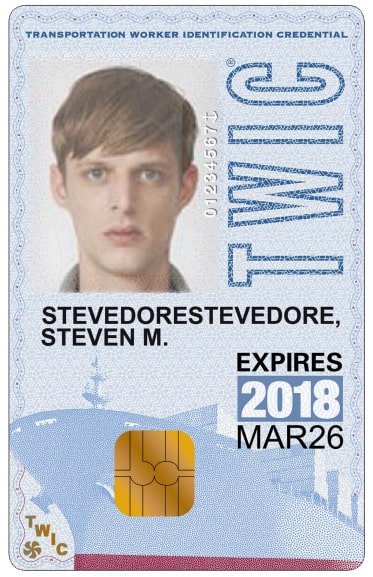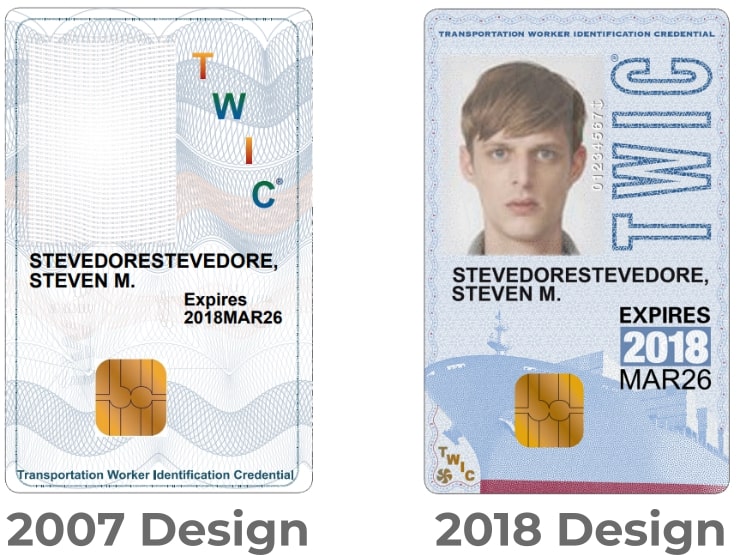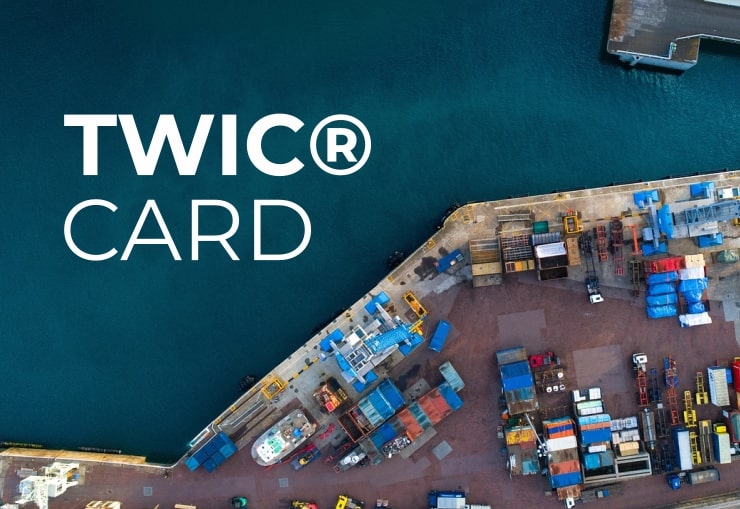The Transportation Worker Identification Credential (TWIC) card represents a pivotal element in enhancing the security of the United States’ transportation systems. Developed as a response to heightened security needs, the TWIC program is a critical tool for ensuring that individuals who have unescorted access to secure areas of maritime facilities and vessels are properly vetted.
This is a concise guide, specifically tailored for newcomers and truckers in the transportation industry, offering essential insights into obtaining and utilizing a TWIC card.
- What is a TWIC card?
- Who needs a TWIC card?
- Do truck drivers need a TWIC card?
- How to get a TWIC card?
- How to check TWIC card status?
- Disqualifying factors and waivers
- How long does a TWIC card last?
- How to renew your TWIC card?
- How to report a lost, stolen, or damaged TWIC card?
- What technology is used for the TWIC card?
- Penalties for non-compliance
- Wrapping-up
What is a TWIC card?
A TWIC card is a tamper-resistant credential mandated by the federal government for all personnel requiring unescorted access to secure areas of maritime facilities and vessels, as well as for all mariners holding Coast Guard-issued credentials.
The card contains the holder’s biometric data, primarily for identification and security purposes, aligning with the Maritime Transportation Security Act of 2002.
It’s a critical component in safeguarding our nation’s ports, waterways, and transportation infrastructure against potential threats while ensuring a streamlined, secure flow of commerce and personnel.

Who needs a TWIC card?
A TWIC (Transportation Worker Identification Credential) card is required for individuals who need access to secure areas of maritime facilities and vessels regulated under the Maritime Transportation Security Act. This includes maritime employees, port facility workers, longshoremen, truck drivers who access port facilities, and others working in secure areas of the maritime transportation sector. Additionally, most mariners licensed by the U.S. Coast Guard also require a TWIC card. It’s a crucial tool for ensuring security and preventing unauthorized access in sensitive maritime environments.
Do truck drivers need a TWIC card?
As a truck driver, you would need a TWIC card if your job requires access to secure and restricted areas of maritime facilities and vessels, particularly those regulated under the Maritime Transportation Security Act.
This typically includes transporting goods to and from ports, loading and unloading cargo at maritime facilities, or accessing shipping containers in restricted areas. The TWIC card is essential for seamless and authorized entry into these secure maritime locations, ensuring compliance with national security regulations.
How to get a TWIC card?
To get a TWIC card, you need to follow a 6-step process, while few requirements should be met.
The process to obtain a TWIC card from start to finish, begins with confirming your eligibility. This critical first step is open to U.S. citizens, lawful permanent residents, and certain immigrants, though be mindful that incomplete applications or specific criminal offenses such as can lead to denial. It means that a TWIC card get you through TSA, and you pass a TSA security threat assessment, including a criminal history background check, review of immigration status, and checks against terrorist watch lists.
ℹ️ Security Threat Assessment (STA)
he Security Threat Assessment for the TWIC card is a comprehensive evaluation by the Transportation Security Administration (TSA). This assessment is crucial to ensure that individuals granted unescorted access to secure maritime areas do not pose a security risk. It’s a key measure to uphold national and transportation security by vetting individuals thoroughly.
Next, dive into the application process. You have the flexibility to apply online or opt for in-person processing at a TWIC application center. This stage demands careful submission of your personal and professional information, a key factor in evaluating your application.
Scheduling an appointment marks the third phase. This can be efficiently handled online or by dialing (855) 347-8371 during the week. While walk-ins are accommodated, securing an appointment is recommended to expedite the process.
The fourth step takes you to the TWIC application center. Here, you’ll present the required documents like your passport or driver’s license along with your birth certificate. This visit includes fingerprinting and photographing, integral to your TWIC card creation.
When it comes to fees, the fifth stage is where you make the necessary payment. Costs vary based on your application type – new, renewal, or replacement – and range between $60.00 and $125.25.
Consider the possibility of a reduced fee of $93.00 for new applicants instead of $125.25. Holding a driver’s license with a hazardous materials endorsement or a FAST card makes you eligible for a discount. Ensure to present these documents when applying to avail of the reduced rate. Payment methods include credit cards, money orders, company checks, or certified/cashier’s checks.
Finally, it’s time to get your TWIC card. After completing your application and payment, choose whether to have the card mailed or to collect it from the center. Remember, you can track your application’s progress online anytime.
How to check TWIC card status?
To check the status of your TWIC card, you can easily do so online. Visit the Universal Enrollment Services (UES) website, where you’ll find an option to check the status of your TWIC application.
You’ll need to enter some personal information, such as your application ID or your full name, date of birth, and the last four digits of your Social Security number. This process provides a quick and convenient way to stay updated on the progress of your TWIC card application.
Disqualifying factors and waivers
For the TWIC card, disqualifying factors include serious criminal convictions, findings of being a security threat, certain immigration status issues, or connections to terrorism. However, there is a provision for waivers. Applicants who have disqualifying factors may request a waiver, which TSA evaluates on a case-by-case basis. The waiver process involves a detailed review of the applicant’s unique situation to make an informed decision.
How long does a TWIC card last?
TWIC cards are valid for five years from the date of issuance. The expiration date is clearly printed on the card.
How to renew your TWIC card?
Before the card expires, holders need to renew their TWIC card. The renewal process involves a new application, including updated documentation and fees. It’s advisable to start the renewal process well in advance of the expiration date to avoid any lapse in certification.
For certain eligible individuals, the renewal process can be completed online, offering a convenient and time-saving alternative.
How to report a lost, stolen, or damaged TWIC card?
If your TWIC (Transportation Worker Identification Credential) card is lost, stolen, or damaged, it’s important to report it immediately. You should contact the Universal Enrollment Services (UES) as soon as possible. This can be done either by calling their help desk or through their website. When reporting, you’ll need to provide relevant details about your card and the circumstances of the loss, theft, or damage. Once reported, you can then proceed to request a replacement card, which involves additional fees and potentially revisiting a TWIC enrollment center for re-enrollment, especially if your biometric data (like fingerprints) needs to be recaptured. Prompt reporting is crucial to prevent any potential misuse of your TWIC card.
What technology is used for the TWIC card?
The standard TWIC (Transportation Worker Identification Credential) card is equipped with various physical and technological features aimed at security. It is tamper-resistant, challenging to forge or alter, and includes the holder’s photograph for visual verification. The card also features holographic images and intricate background patterns for added security.
Building upon this, the TWIC® NexGen card introduces further advancements. Like its predecessor, the TWIC NexGen card is designed with multiple physical and technological safeguards. It is tamper-resistant, a crucial feature that significantly reduces the possibility of forgery or unauthorized alterations. This enhanced security is achieved through the inclusion of a holder’s photograph for visual verification and additional security elements such as holographic images and complex background patterns, which are intricately designed and challenging to replicate.

Furthermore, the TWIC® NexGen card incorporates advanced technology features, improving upon the standard TWIC card’s security measures. These enhancements include features like tactile printing and an Integrated Circuit Chip. The chip contains the cardholder’s name and photograph, card expiration date, and two biometric fingerprint templates. This addition not only boosts the card’s security against counterfeiting but also facilitates more efficient and secure verification processes at checkpoints.
Together, these features make the TWIC® NexGen card a more secure and reliable identification credential, ensuring the highest standards of security for access to maritime facilities and vessels.
Biometric and RFID Technology
A key technological aspect of the TWIC card is its biometric capability. The card stores the holder’s fingerprint data, which can be used for biometric verification at secure locations. This feature adds an extra layer of security by ensuring that the card is being used by its rightful owner. Additionally, the card is equipped with Radio-Frequency Identification (RFID) technology. This allows for contactless reading of the card at short distances, facilitating quicker and more efficient verification processes at entry points.
Penalties for non-compliance
Non-compliance with TWIC regulations can result in significant penalties. This includes fines for both employers and employees, and in severe cases, can lead to operational restrictions or shutdowns for non-compliant facilities. Employees found without a valid TWIC card in secure areas may face access denial and potential legal action.
The Secretary of the Department of Homeland Security (DHS) can enforce civil penalties up to $10,000 for TWIC-related regulations.
Wrapping-up
The Transportation Worker Identification Credential (TWIC) card is more than just a compliance requirement. For those in the transportation sector, particularly those interacting with maritime environments, it’s a crucial tool that ensures both personal access and national security.
As a trucker, holding a TWIC card not only grants you the necessary clearance to enter and operate within secure maritime areas but also aligns you with the broader efforts to maintain the safety and security of critical transportation infrastructure. This credential, therefore, is integral to your professional toolkit, enabling you to seamlessly fulfill your role while upholding the highest standards of security in the transportation industry.

